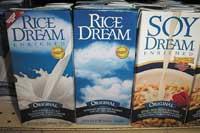Soy: still unknown?
2001/01/01 Lorenzo, Arantza | Uranga, Ane Miren Iturria: Elhuyar aldizkaria
It comes in various forms: soybean seed, soybean, soybean oil, soy lecithin, etc. Although all have the same ingredients, the difference is in their quantity, being the richest the soybean. The latter is mainly used as raw material for the production of industrial foods, since its technological and nutritional properties are considered very adequate.
35-40% of soybean is protein. In addition, unlike the rest of the legumes, it contains large amounts of sulfur amino acids (methionine, cysteine), which allows us to consider all the protein for our body.
About 20% of soy is made up of fats. Soybean oil contains polyunsaturated fatty acids essential for the human body, linoleic acid and linolenic acid, so it has the property of lowering blood cholesterol levels.
Carbohydrates also account for 20% and are mostly oligosaccharides, offering a relatively small amount of fiber and starch.
Mineral salts containing soybean are iron (15.7 mg/100 g; five times more than meat), calcium, phosphorus, potassium, and magnesium. It hardly contains sodium, so it is highly recommended for people with heart problems or stress.
As for vitamins, the ones of group B are abundant: B1, B2, B6 and vitamin E.
On the other hand, soybeans also contain phytochemical elements that are lately found in some foods, especially of vegetable origin. These are not properly considered foods, but they do function as protectors in certain diseases and alterations. The main ones are:
- Isoflavones: the most important non-nutritious element of soy. Soy specifically contains phytoestrogens (female hormones of vegetable origin). They have effects similar to those of estrogens, but without unpleasant consequences: they help maintain hormonal balance in women, regulating menstruation and protecting from menopausal alterations.
- Phytosterols: substances similar to vegetable cholesterol. In part, they make it difficult to absorb the cholesterol we eat through food, avoiding its increase in blood.
For all these reasons, we would advise the progressive introduction of soy in our diet. Since the richest is soybean, like any other legume, it would be beneficial to eat a dish every week or fortnightly.

Gai honi buruzko eduki gehiago
Elhuyarrek garatutako teknologia





